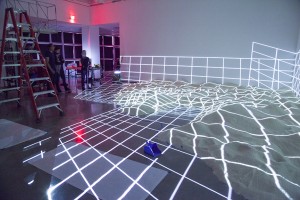Lessons from Luftwerk’s Solarise: A Sea of All Colors
Solarise: A Sea of All Colors, is an exhibition of light and sculptural installations by the artist duo Luftwerk on view at the Garfield Conservatory in Chicago. This new project is ambitious in scale, extending Luftwerk’s application of digital and physical materials as they consider the environmental and social impact of their rapidly growing studio. On Tuesday September 29th 2015, Petra Bachmaier, co-founder of Luftwerk, spoke at Alfred University’s Nevins Auditorium about the installation and design of Solarise.

In recent years, Luftwerk have worked across Alfred University’s School of Art and Design to accomplish collaborative and individual projects. Bachmaier is the current Theodore Randall International Chair in the Division of Sculptural and Dimensional Studies. Luftwerk’s Spectrum, a video projection map on a large digital print, is now on view at Alfred University’s Fosdick Nelson Art Gallery. Spectrum is part of Typology/Morphology, a group exhibition from the Institute for Electronic Arts (IEA) highlighting print works by 26 resident artists. In 2014-15, Luftwerk collaborated with D. Chase Angier on her performance installation, As The Air Moves Back From You, also presented at the Fosdick Nelson Gallery. Like many of Luftwerk’s previous projects, As The Air Moves Back From You required complex digital projection mapping of an architectural space.

Solarise sets in motion bespoke LED video displays and analog applications of transparency and light across five new installations works. Seed of Light is a circular chandelier that reflects droplets and rippling water onto the floor of Garfield’s Horticulture Hall. Florescence applies a floral pattern of red and blue translucent Perspex to the arched conservatory ceiling. Throughout the day, directional sunlight projects color and overlapping shapes onto the floor below. After dark, artificial light illuminates the room. The Beacon consists of a parallel series of LED’s magnetically adhered to Garfield’s front entry scaffolding. These display footage of plants blowing according to live data that reflects local Chicago wind speeds. Portal and Prismatic activate light and reflection through sculptural forms within the Garfield Conservatory building.
Luftwerk’s intent is to control the environmental impact of Solarise, which must remain installed and robust for a year-long exhibition period. Bachmaier stated that, “With video and light you can greatly transform a space without interrupting the building at all.”((Petra Bachmaier, Alfred University, Nevins Auditorium, September 29, 2015.)) Each installation in Solarise breaks down to modular parts that easily disengage with the architecture of the 1908 conservatory structure. The artworks that use LED’s or consume electricity are powered through solar cells. Throughout the installation period in the summer of 2015, Luftwerk built relationships with contractors who were hired from the neighborhood surrounding the conservatory. No one traveled more than a mile to install the piece on a given day. This not only employed local workers, but also curtailed the carbon emissions that would have resulted from longer commutes.

Solarise: A Sea of All Colors serves as a useful case study for new media artists who want to work at an architectural scale. Luftwerk’s methods draw upon sculpture, projection, and light while activating visitor participation across a grand space. Their consideration of the environmental impact of the work will be beneficial throughout the duration of the exhibition. Luftwerk were savvy in their use of practical and aesthetic strategies that circumvent many of the issues that can arise with the use of high-powered projectors and computing systems. When other new media installations would require the repair of equipment or the replacement of bulbs, Solarise’s analogue luminescence will continue to glow.


